ACOUSTICS: Ten times the logarithm (to the base ten) of the ratio of two mean square values of Sound Pressure, voltage, or current. The abbreviation for "decibels" is dB. [Hirschorn, Martin; Compendium of Noise Engineering - Part I Sound & Vibration Magazine, July 1987.]
The decibel (symbol: dB) is a relative unit of measurement corresponding to one tenth of a bel (B).
The definition of the decibel originated in the measurement of power in telephony of the early 20th century in the Bell System in the United States. One decibel is one tenth (deci-) of one bel, named in honor of Alexander Graham Bell; however, the bel is seldom used.
The logarithmic ratio of the output voltage (Vout) to the input voltage (Vin) expressed as: dB = 20 log (Vout/Vin), and may designate either network gain or attenuation.
abbreviated "db" is the standard measure of loudness. It is a relative measurement, used to compare two different loudness levels. For instance, if a loudspeaker is "5 db down at 40 cycles" (usually written "-5 db"), the sound it produces at a frequency of 40 cycles per second is 5 db softer than the sound it produces at a standard reference frequency - usually 1000 Hz. The smallest readily apparent loudness difference in music is 3 db, though sharp-eared listeners may discern differences as small as 1 db. [Fantel, Hans; The True Sound of Music - A Practical Guide to Sound Equipment for the Home, 1973, E. P. Dutton & Company, Inc., New York]
See this excellent article: https://www.sizes.com/units/decibel.htm?fbclid=IwAR0MvB-xfP6K-ctF29u9Ct8Qo0KKIVjQXgvz7rbm8NU9sKYikXkBZxZG0hI

See Also
